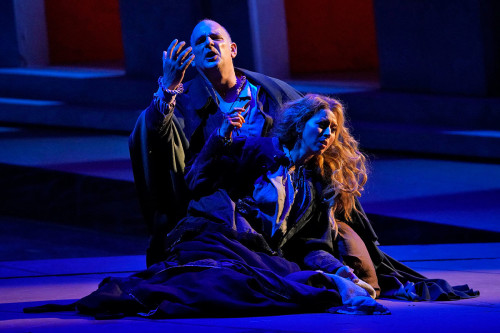 United States Verdi, Rigoletto: Soloists, Chorus and Orchestra of LA Opera / Matthew Aucoin (conductor), Dorothy Chandler Pavilion, Los Angeles, 12.5.2018. (JRo)
United States Verdi, Rigoletto: Soloists, Chorus and Orchestra of LA Opera / Matthew Aucoin (conductor), Dorothy Chandler Pavilion, Los Angeles, 12.5.2018. (JRo)

Cast:
Rigoletto – Juan Jesús Rodríguez
Gilda – Lisette Oropesa
Duke of Mantua – Arturo Chacón-Cruz
Count Monterone – Craig Colclough
Sparafucile – Morris Robinson
Maddalena – Ginger Costa-Jackson
Marullo – Juan Carlos Heredia
Borsa – Joshua Wheeker
Count Ceprano – Gabriel Vamvulescu
Giovanna – Sharmay Musacchio
Countess Ceprano – Liv Redpath
Page – Michelle Siemens
Creative team:
Director – Mark Lamos
Sets – Michael Yeargan
Costumes – Constance Hoffman
Lighting – Robert Wierzel
Chorus Director – Grant Gershon
It’s no wonder that LA Opera has revived its 2010 production from San Francisco of Rigoletto. The imaginative sets, stunningly lit with painterly precision, pitch-perfect costumes and superb direction make it a production worth seeing again.
As father and daughter, Rigoletto and Gilda, Juan Jesús Rodriquez and Lisette Oropesa were a heart-wrenching pair, thoroughly believable, whether in the throes of tender feelings or violent emotion. Oropesa, the willowy and captivating soprano last seen in Los Angeles in Gluck’s Orphée and Eurydice, brought to life the cloistered daughter of Rigoletto who falls in love with her seducer, the Duke of Mantua, and is ultimately abducted by his courtiers, then compromised and abandoned by the Duke.
Nowhere was the drama more gripping than in the scenes of Rigoletto and Gilda. Rodriquez, tall and powerful, was the perfect counterpart to the youthful and lithe Oropesa. When she was enfolded in his arms, it was enough to make tears flow. Oropesa’s expressive and beautifully modulated soprano gave full range to Gilda’s every emotion. Her love and regard for her father was palpable from their first duet in Act I to Act II’s ‘Piangi, fanciulla’ to their final tragic duet, ‘Lassù in cielo’, as Gilda dies in Rigoletto’s arms.
Rodriquez mastered both the dark and soft side of Rigoletto’s nature with a velvety baritone that spoke of his depth of feeling, whether conspiring with the assassin Sparafucile, railing against the courtiers or singing of his love for Gilda’s deceased mother. He brought a querulous dignity to the role of the court jester, which put me in mind of Domenico Tiepolo’s extraordinary eighteenth-century Punchinello drawings and frescoes.
Oropesa ignited the performance of Arturo Chacón-Cruz as the duke, especially in the duet ‘Addio speranza ed anima’. It was here, when the duke, disguised as a student, snuck into the house of the unsuspecting Gilda and proclaimed his love for her, that Chacón-Cruz was at his best. Elsewhere, the tenor, though exuberant and committed, tended to play the role as a carousing fraternity boy rather than an arrogant, entitled and lascivious nobleman. But perhaps it was Oropesa’s interpretation of innocence destroyed that best captured the heart and soul of this production. When she sang her glowing first act aria, proclaiming her love for the young student, one shuddered, knowing of the tragic events to come.
Michael Yeargan’s set design featured a stark street scene of tilted building facades receding in sharp perspective, creating an off-kilter world of menace. The set’s brilliance lay in its simplicity, which allowed for multiple transformations. When lit with the painterly light created by Robert Wierzel, the effect was dazzling – a cadmium red glow within Rigoletto’s home, an acid green light emanating from arched doorways, purple exterior walls, yellow skies.
Adapted by librettist Francesco Maria Piave from Victor Hugo’s play Le roi s’amuse, the opera is set in the sixteenth century. Constance Hoffman’s costume designs were faithful to the period, channeling the etchings of Jacques Callot and, like Callot, Hoffman managed to infuse the noblemen’s’ attire with humor. In Act II, when the courtiers describe their abduction of Rigoletto’s so-called mistress, members of the chorus are bedecked in commedia dell’arte masks and decorative trousers as they re-create the event to giddy effect.
Staging the opera and creating one luminous whole, Mark Lamos was able to add notes of gaiety to an otherwise tragic drama and kept the action on stage tightly wound and deeply affecting. The LAO Chorus and Orchestra were in fine form under the baton of Artist in Residence, Matthew Aucoin.
Of particular note was Morris Robinson’s Sparafucile, whose textured bass is always splendid and whose charisma served the role as hired assassin well. Mezzo Ginger Costa-Jackson as Maddalena, the seductress who lures Sparafucile’s victims to the inn, was an appealing presence but fell short in the Act III quartet, unable to be heard distinctly among the voices of Rodriquez, Oropesa and Chacón-Cruz.
The vitality of Rigoletto, brought to life by Verdi’s intensely felt music and this timeless production, is not to be missed.
Jane Rosenberg
